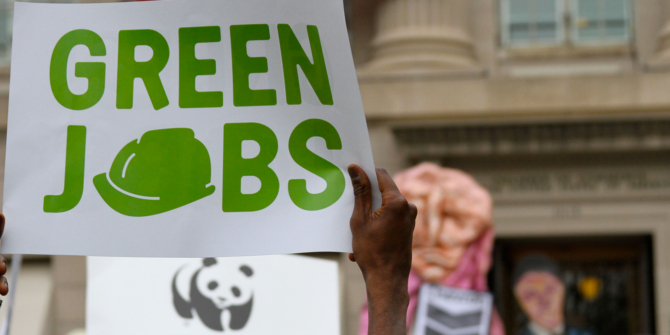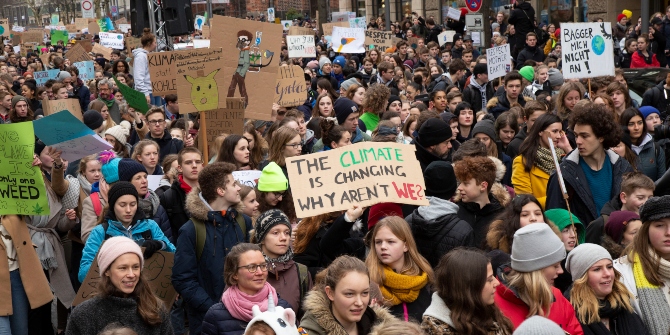Advances in synthetic biology are enabling the engineering of biological components to build applications in a wide array of fields, from medicine to manufacturing and beyond. The benefits of synthetic biology to solving global challenges are immense, but there are concerns about new forms of misuse it might enable. To safeguard our future, the executive director of bio policy and leadership initiatives at Stanford University, Megan Palmer, says we need to enable everyone to build with biology and to bake biosecurity into the pursuit of peaceful purposes. Dr Palmer sat down for a brief Q&A with LSE Business Review’s managing editor, Helena Vieira, during the World Economic Forum’s Great Narrative meeting in Dubai.
Question: You spoke about synthetic biology and the role that it can play in fighting climate change. Can you say a bit more about this?
First, we need to look at the long history of humans interacting with the living world. We are biological beings and everything that we are, everyone we love, every living thing on this planet came from biology. We can draw inspiration from biology because it has already evolved millions of replicating sustainable solutions in terms of species that survive and thrive nearly everywhere on Earth starting from only sunlight, air, water and soil. We already rely on things biology has built for food, fuel, medicine and shelter. Synthetic biology really represents the next stage in the evolution of our direct interactions with this living matter, by allowing us to design at the level of the underlying genetic code, to synthesize or create new useful things with biology. And that means we can better harness 4 billion years of evolution with biological systems and the toolset that this has created to come up with more sustainable solutions not just in food, materials, fuel, and energy, but also in an increasing number of areas that are valuable for our economies, our lives, and our societies. Synthetic biology is really the toolset underlying the so-called bioeconomy that represents the value that we can derive from biological processes These technologies can be more sustainable by design, and replace extractive industries that are messing up the planet.
Question: You also talked a little bit about CRISPR. I’m curious about something you said about allowing everyone to create or to engineer with synthetic biology.
Imagine actually being able to use and develop and really co-create new technology in partnership with biology. People everywhere in the world have problems they might want to solve with biological technologies – fighting disease, remediating the environment, producing materials, fuels, medicines, and more. We have already re-discovered and modified biological technologies like CRISPR that enable us to interact with the underlying genetic code of biological systems with more precision and ease. And now we can use not just things like CRISPR, but a whole suite of tools to read, write, edit and evolve these systems to do useful things. What are the opportunities with this new set of tools? We need to reimagine the infrastructure that supports those tools so that they enable everyone, everywhere, to be able to build with biology. If you think about it, biology is already everywhere; we have all the ingredients around us to enable people to come up with new and better solutions to many needs in many contexts. It also means we can reimagine not necessarily having centralised manufacturing but more distributed systems that enable us to use the biology all around us to do new and wonderful things. That’s a big opportunity. Perhaps we don’t need to industrialise biology but rather think about how we biologise industry and use biology as inspiration to reimagine the ways we think about industry, our role in the living world, and our role as stewards of this planet.
Question: There’s also another side to democratising access to synthetic biology: you risk increasing misuse. How do you ensure against it?
That’s a key challenge. One of the things to remember, though, is that we are already in a state where we need to protect against emerging and re-emerging infectious disease. There are also other threats to our safety and security that biology can help protect us from, including climate change. So, we are not at a starting point of being safe and secure. The challenge is therefore figuring out how we develop the tools and capabilities and cultures to bias towards protection, while also safeguarding the possibilities of developing biological innovations for peaceful purposes. One of the ways to be more secure is to give everyone the tools to be able to defend against biological threats and be able to come up with solutions to ensure our security and more sustainable ways of living. But to do that we also need to enable everyone to respect that there are territories that we do not want to stray into. One of our most important safeguards against misuse, that is only 50 years old is the Biological Weapons Convention. We remarkably have come together across the world and said, “We do not use biology for harm”. The agreement to not weaponize is a choice and is the foundational safeguard that enables us all to benefit from biology. Now this is not sufficient, but it is a critical starting point. We also need to build norms, institutions and practices that enable everyone to navigate ambiguity and uncertainty around harms that can be hard to classify and anticipate. But because biology is everywhere and increasingly available you ultimately can’t lock up the tools. You therefore have to create a culture around those tools where people are expected to be vigilant in keeping themselves and others away from harmful territories, and to build ways to quickly detect and respond to things might that go wrong including accidents. They also need to be aware they might be wrong. It’s going to take both technical and social approaches, but if we bake in biosecurity, we can grow a type of global immune systems we will need to safeguard our future.
Question: Towards the end of your talk, you said we’re all biological beings, so we have to go beyond the human-centric vision. Does that mean that plants and other animals must be given the same level of respect that we have for human beings?
As humans, we carry all sorts of different beings in our bodies already. We have a microbiome that supports our bodies. Th planet nourishes us already. So, it’s not just a matter of respect, but of awe of our place in the living world. We can’t do it alone, and we wouldn’t want to. And it’s also thinking about partnerships. How do we have a partnership with the microbes that are making our beer or our bread? It’s realizing that we’re already in that state of being coupled with many other systems. So, it’s revisiting what already existed before in terms of a relationship with many other living beings that support us and our planet and asking what new relationships we might need to form as we engage with even more intention and power. In another example, I’ve also been inspired by using biotechnology enabled approaches to rescue endangered species where other conservation approaches have failed. This year Elizabeth Ann, a critically endangered Black Footed Ferret, was cloned from cells frozen down over 30 years ago. We have the opportunity to rethink how we not only preserve the future our species also preserve the future of other species while we seek to stem the reasons we are rapidly losing biodiversity.
Question: Are synthetic animal meat and products part of the solution?
I definitely think so. There is a real opening up of possibilities in this space. We already have plant-based burgers that taste and smell like meat thanks to the addition of heme, a blood protein, that was grown by microbes like beer. These burgers can be produced much more sustainably than meat from a cow, and they are tasty. And there is a lot of interest in mycelium, or mushrooms, that can be grown to create not only replacements for animal-based leather but other types of materials for packaging or construction. If we look at the genes from different species as code or as a toolset that can enable different applications where we don’t have to have the whole animal or other organisms involved, we can also now have spider silk without the spiders. It allows us to think about other options that are more harmonious with the living world. We don’t have to be as exploitative. We can be regenerative in our approaches.
Question: And fight diseases, and aim at immortality…
There’s a question of how we look boldly at the worlds we might create while not being blind to the harms that can be created along the way. What would it mean to be able to catch pandemics before they start, to understand threats before they become things that we cannot control? That’s a world I think I would like to live in – but there are versions of that future that enable everyone to be more free and secure and to live a good life, and there are others versions that try to achieve that goal through exacerbating inequities, limiting freedoms and driving fear. So, I think we need to be inspired by biology to ask, “how do we design an ecosystem that functions and flourishes by enabling many different species?” You don’t want to drive towards all the extremes. You want to benefit from biodiversity and balance and being able to think about maintaining diversity and resilience. It’s not about immortality and I personally don’t want to build or live in a future driven by the dreams of a few people who want to live forever. A better dream is about how we live well with each other for the benefit of all.
♣♣♣
Notes:
This is the fourth in a series of five interviews that took place during the World Economic Forum’s Great Narrative meeting in Dubai (11-12 November 2021).
- This interview represents the views of the interviewee, not the position of LSE Business Review or the London School of Economics.
- Featured image: Megan J. Palmer, Courtesy of Stanford University.
- When you leave a comment, you’re agreeing to our Comment Policy.






1 Comments